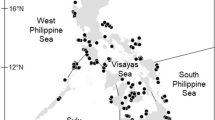Summary
Despite the pre-eminence of the Great Barrier Reef, there has been little systematic description of its biotic communities, and in particular, of the corals themselves. Only recently have the problems of coral taxonomy been sufficiently resolved to allow a beginning to be made in rectifying this deficiency. The present study describes seventeen assemblages of corals which occupy the major habitat types found in and near the central Great Barrier Reef. The habitats studied range from the wave swept reef flats of Coral Sea atolls to the slopes of small reefs occupying sheltered, muddy conditions near the coast. These, and the array of reefs between, have characteristic suites of coral communities which provide the basis for a classification of reefs into non-Acropora reefs and various Acropora reefs. It is speculated that the faunistic differences are maintained because reefs are primarily self-seeded and because the majority of larvae from external sources are of species which are already present. The greatest diversity of both species and community types was found on reefs near the middle of the continental shelf, while the oceanic atolls and nearshore silt-affected reefs are almost equally depauperate.
Similar content being viewed by others
References
Adey WH, Burke RB (1977) Holocene bioherms of Lesser Antilles-Geologic control of development. Am Assoc Petrol Geol Studies. Geol 4:67–81
Andrews JC, Gentien P (1982) Upwelling as a source of nutrients for the Great Barrier Reef ecosystems: a solution to Darwin's question? Mar Ecol Prog Ser 8:257–269
Bothwell AM (in press) Fragmentation, a means of asexual reproduction and dispersal in the genus Acropora. Proc 4th Int Coral Reef Symp, Manila
Chappell J (1980) Coral morphology, diversity and reef growth. Nature 286:249–252
Connell JH (1973) Population ecology of reef-building corals. In: Jones OA, Endean R (eds), Biology and geology of coral reefs II. Biology I. Academic Press, New York London, pp 205–245
Connell JH (1978) Diversity in tropical rain forests and coral reefs. Science 199:1302–1310
Done TJ (in press) Coral zonation, its nature and significance. In:Barnes DJ (ed) Perspectives on coral reefs. Australian Institute of Marine Science. Townsville
Done TJ (in press) Photogrammetry in coral ecology: a technique for the study of change in coral communities. Proc 4th Int Coral Reef Symp, Manila
Done TJ, Kenchington RA, Zell LD (in press) Rapid, large area reef resource surveys using a manta board. Proc 4th Int Coral Reef Symp, Manila
Geister J (1977) The influence of wave exposure on the ecological zonation of Caribbean coral reefs. Proc 3rd Int Coral Reef Symp, Miami, vol 1, pp 23–29
Krebs CJ (1978) Ecology: the experimental analysis of distribution and abundance, 2nd edn. Harper and Row, New York
Lewis JB (1974) the settlement behaviour of planulae larvae of the hermatypic coral Favia fragum (Esper.) J Exp Mar Biol Ecol 15:165–172
Maxwell WGH (1968) Atlas of the Great Barrier Reef. Elsevier Scientific Publishing Company, Amsterdam
Ott B, Auclair AN (1977) Cluster-analytic definition of species ecological groups for a submerged barrier reef in Barbados, West Indies. Int Rev Ges Hydrobiol 62:41–51
Pearson RG (1974) Recolonization by hermatypic corals of reefs damaged by Acanthaster. Proc 2nd Int Symp Coral Reefs, Brisbane, vol 2, pp 207–215
Pearson RG (1981) Recovery and recolonization of coral reefs. Mar Ecol Prog Ser 4:105–122
Pichon M (1978) Recherches sur les peuplements à dominance d'anthozoaires dan les recifs coralliens de Tuléar (Madagascar). Atoll Res Bull 222:1–447
Rinkevich B, Loya Y (1979) The reproduction of the Red Sea coral Stylophora pistillata. II. Synchronization in breeding and seasonality of planulae shedding. Mar Ecol Prog Ser 1, pp 145–152
Rosen BR (1971) Principal features of reef coral ecology in shallow water environments of Mahe, Seychelles. Symp Zool Soc Lond 28:103–183
Rosen BR (1975) The distribution of reef corals. Rep Underwater Assoc 1:2–16
Rosen BR (1980) The tropical high diversity enigma—the corals'-eye view. In: Forey PL (ed) The evolving biosphere. Cambridge University Press, Cambridge, pp 103–129
Sheppard CRC (1982) Coral populations on reef slopes and their major controls. Mar Ecol Prog Ser 7:83–115
Veron JEN, Done TJ (1979) Corals and coral communities of Lord Howe Island. Aust J Mar Freshwater Res 30:203–236
Veron JEN, Pichon M (1976) Scleractinia of Eastern Australia Part I. Families Thamnasteriidae, Astrocoeniidae, Pocilloporidae. Australian Institute of Marine Science Monograph Series 1, pp 1–86
Veron JEN, Pichon M (1979) Scieractinia of Eastern Australia Part III. Families Agariciidae, Siderastreidae, Fungiidae, Oculinidae, Merulinidae, Mussidae, Pectiniidae, Caryophylliidae, Dendrophylliidae, Australian Institute of Marine Science Monograph Series 4, pp 1–422
Veron JEN, Pichon M, Wijsman-Best M (1977) Scleractinia of Eastern Australia Part II. Families Faviidae, Trachyphylliidae. Australian Institute of Marine Science Monograph Series 3, pp 1–212
Wallace CC (1978) The coral genus Acropora (Scleractinia: Astrocoeniina: Acroporidae) in the central and southern Great Barrier Reef Province. Mem Queensland Museum 18:273–319
Wallace CC, Dale MB (1977) An information analysis approach to zonation patterns of the coral genus Acropora on outer reef buttresses. Atoll Res Bull 220:95–110
Wells JW (1954) Recent corals of the Marshall Islands. United States Geol Surv Prof Pap 260-I, pp 285–486
Wells JW (1957) Coral reefs. Mem Geol Soc Am 67:609–631
Williams DMcB (1982) Patterns in the distribution of fish communities across the central Great Barrier Reef. Coral Reefs 1:35–43
Wishart D (1978) Clustan user manual. Program Library Unit, Edinburgh University
Wolanski E (1982) Fate of Burdekin River Flood Waters in the Great Barrier Reef. Hydrology and Water Resources Symposium (1982: Melbourne). Preprints of papers, pp 23–27
Wolanski E, Jones M (1981) Physical properties of Great Barrier Reef Lagoon waters near Townsville. I. Effects of Burdekin River floods. Aust J Mar Freshwater Res 32:305–19
Author information
Authors and Affiliations
Rights and permissions
About this article
Cite this article
Done, T.J. Patterns in the distribution of coral communities across the central Great Barrier Reef. Coral Reefs 1, 95–107 (1982). https://doi.org/10.1007/BF00301691
Received:
Accepted:
Issue Date:
DOI: https://doi.org/10.1007/BF00301691




